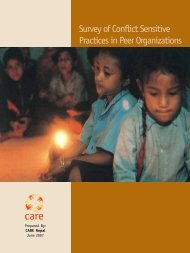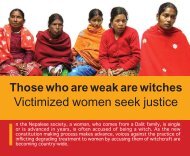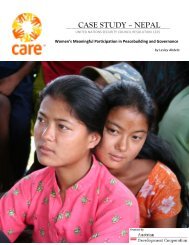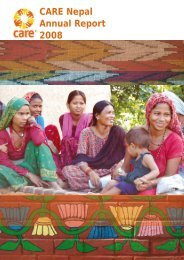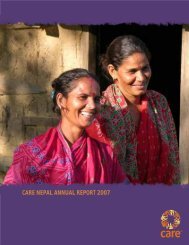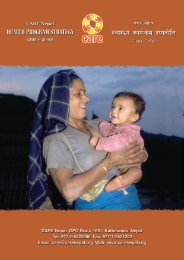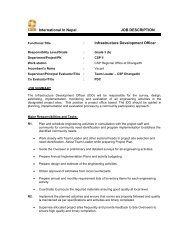Untitled - Care Nepal
Untitled - Care Nepal
Untitled - Care Nepal
Create successful ePaper yourself
Turn your PDF publications into a flip-book with our unique Google optimized e-Paper software.
cooperation of the Royal <strong>Nepal</strong> Army<br />
(Gregson, 2002; Thapa, 2007). Gyanendra<br />
was in Pokhara at the time of the massacre,<br />
and thus his life was spared. Gyanendra’s<br />
son, future Crown Prince Paras, was at the<br />
palace during the massacre but was one of<br />
the few to survive miraculously. The other<br />
major change affecting the People’s War was<br />
the U.S.-led Global War on Terror<br />
beginning in late 2001. The two factors are<br />
believed to be associated with increased<br />
violence used by His Majesty’s Government<br />
against both Maoists and civilians starting<br />
in late 2001, which was when the Royal<br />
<strong>Nepal</strong> Army was first involved in the<br />
conflict.<br />
In November 2001, fighting began between<br />
the Royal <strong>Nepal</strong> Army and the Maoists. The<br />
RNA was supported by U.S. funds for the<br />
War on Terror (Amnesty International, 2005;<br />
Bhattarai et al., 2005; Mehta, 2005). Tactics<br />
such as disappearances, intimidation of<br />
health workers, media censorship, and<br />
torture rapidly spread throughout <strong>Nepal</strong> in<br />
2002 under the Terrorist and Disruptive<br />
Activities Control and Punishment Act<br />
(TADA) (Pettigrew, 2001; Stevenson, 2001).<br />
TADA effectively instituted a state of<br />
emergency and ended civil liberties.<br />
Violence on both sides coevolved during<br />
this period with increasing smaller-scale<br />
acts of brutality as well as large scale battles<br />
(INSEC, 2005). Few sections of the country<br />
escaped the spreading violence.<br />
The seizure of power by King Gyanendra,<br />
withdrawal of civil liberties, and end to<br />
democracy got the attention of the wealthy<br />
and powerful in Kathmandu. In 2006, the<br />
Maoists aligned with other political parties<br />
(the Seven Party Alliance, SPA) and the<br />
media in Kathmandu to take control from<br />
King Gyanendra. Nearly a month of nonviolent<br />
protests by the citizens of <strong>Nepal</strong>—<br />
with rather violent responses by the<br />
police—eventually led Gyanendra to share<br />
power in April 2006. The alliance of the<br />
Maoists with the other political parties held<br />
together after the April non-violent<br />
movement. In November 2006, Prime<br />
Minister Koirala on behalf of the SPA<br />
government and Prachanda on behalf of the<br />
CPN (M) and PLA signed a historic peace<br />
agreement that declared an end to the decade<br />
long People’s War. In total, over 13,000<br />
people were killed during the People’s War,<br />
with the majority of deaths at the hands of<br />
the Royal <strong>Nepal</strong> Army and the government’s<br />
police force (Mehta, 2005).<br />
IMPACT OF CONFLICT<br />
ON WOMEN<br />
The armed conflict has impacted women<br />
in many ways: changed roles and<br />
responsibilities in the family and society;<br />
increased numbers of women-headed<br />
households; increased poverty; increased<br />
vulnerability to and incidence of sexual<br />
violence; and increased anxiety and stress.<br />
Women usually do the household chores,<br />
but due to the conflict men were forced to<br />
migrate to more secure places or to India.<br />
Due to economic crises and security<br />
problems women had to come forward and<br />
bear the overall responsibilities. The reality<br />
that these changes were not voluntary but a<br />
reaction to traumatic experiences worsened<br />
the situation of many women. By taking<br />
8<br />
Psychosocial Issues of<br />
Women affected by conflict



